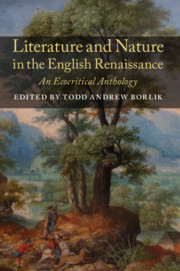Book contents
- Frontmatter
- Contents
- List of Illustrations
- Acknowledgements
- Editorial Principles: Towards the Ecocritical Editing of Renaissance Texts
- Introduction
- PART I Cosmologies
- PART II The Tangled Chain
- PART III Time and Place
- Seasons
- Country Houses
- Gardens
- Pastoral: Pastures, Meadows, Plains, Downs
- Georgic: Fields, Farms
- Forests, Woods, Parks
- Heaths, Moors
- Mountains, Hills, Vales
- Lakes, Rivers, Oceans
- PART IV Interactions
- PART V Environmental Problems in Early Modern England
- PART VI Disaster and Resilience in the Little Ice Age
- Appendix A Industrialization and Environmental Legislation in the Early Anthropocene: A Timeline
- Appendix B Further Reading: A Bibliography of Environmental Scholarship on the English Renaissance
Pastoral: Pastures, Meadows, Plains, Downs
from PART III - Time and Place
Published online by Cambridge University Press: 05 June 2019
- Frontmatter
- Contents
- List of Illustrations
- Acknowledgements
- Editorial Principles: Towards the Ecocritical Editing of Renaissance Texts
- Introduction
- PART I Cosmologies
- PART II The Tangled Chain
- PART III Time and Place
- Seasons
- Country Houses
- Gardens
- Pastoral: Pastures, Meadows, Plains, Downs
- Georgic: Fields, Farms
- Forests, Woods, Parks
- Heaths, Moors
- Mountains, Hills, Vales
- Lakes, Rivers, Oceans
- PART IV Interactions
- PART V Environmental Problems in Early Modern England
- PART VI Disaster and Resilience in the Little Ice Age
- Appendix A Industrialization and Environmental Legislation in the Early Anthropocene: A Timeline
- Appendix B Further Reading: A Bibliography of Environmental Scholarship on the English Renaissance
Summary
Ostensibly set in ancient Greece and inspired by the work of the Italian Jacopo Sannazaro, Sidney's pastoral romance also depicts an idealized Elizabethan countryside, modelled on the Wiltshire estate of his sister, the Countess of Pembroke. Notoriously, much of the Earl of Pembroke's manorial lands had been enclosed in the mid-sixteenth century, and Sidney's dismissive account of the Helot uprising can be viewed as a condemnation of anti-enclosure riots (see Part v). Whereas the previous open-field system allowed commons to be divided into strips and used for multiple purposes, enclosed lands could be made more uniform to maximize profits or impose upon them a consistent landscape design. Achieving “order in confusion,” Kalander's garden rejects both the disorder of the commons and the monoculture of agrarian capitalists, exhibiting a horticultural sprezzatura that disguises the nobility's management of the land as natural. Rather than an escape from history, the Arcadia here foresees the environmental degradation caused by the English Civil War, and its “golden world” reflects a feudal land ethic in which the beauty and ecological stability of the countryside result from aristocratic stewardship.
Source: The Countess of Pembroke's Arcadia (1593), 3v–5v.
In the time that the morning did strew roses and violets in the heavenly floor against the coming of the Sun, the nightingales (striving one with the other which could in most dainty variety recount their wrong-caused sorrow °) made them put off their sleep, and rising from under a tree (which had that night been their pavilion) they went on their journey, which by and by welcomed Musidorus' eyes, wearied with the wasted soil of Laconia, with delightful prospects.
There were hills which garnished their proud heights with stately trees; humble valleys whose base estate seemed comforted with refreshing of silver rivers; meadows enamelled with all sorts of eye-pleasing flowers; thickets which, being lined with most pleasant shade, were witnessed so to by the cheerful disposition of many well-tuned birds; each pasture stored with sheep feeding with sober security, while the pretty lambs with bleating oratory craved the dams' comfort; here a shepherd boy piping as though he should never be old; there a young shepherdess knitting and withal singing, and it seemed that her voice comforted her hands to work and her hands kept time to her voice's music.
- Type
- Chapter
- Information
- Literature and Nature in the English RenaissanceAn Ecocritical Anthology, pp. 246 - 257Publisher: Cambridge University PressPrint publication year: 2019



